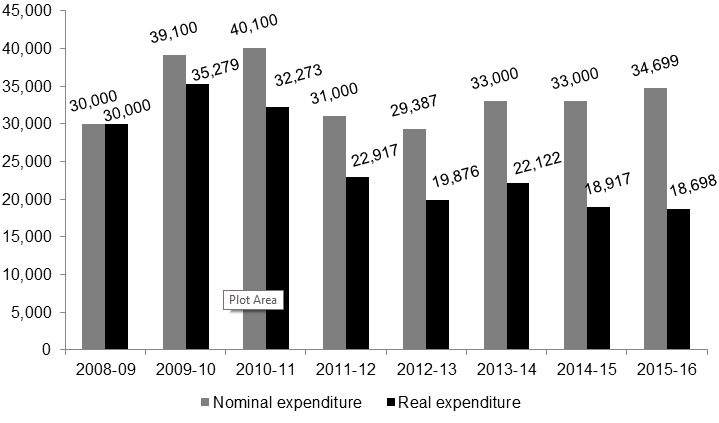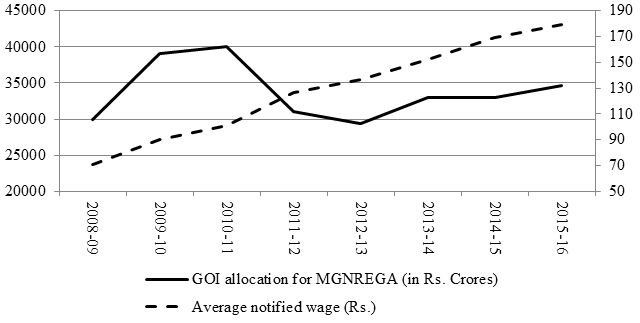Fund allocation for MNREGA has seen a steady decline in real terms over the last few years. Analysing official MNREGA data along with survey data from Rajasthan, this column shows that in the face of limited financial resources, local implementers are more likely to allocate MNREGA jobs based on discretion and political motives.
Generation of employment under the Mahatma Gandhi National Rural Employment Guarantee Act (MNREGA) has seen a sharp decline from the peak of 2,840 million person-days in 2009-10 to 1,550 million person-days last year – a drastic reduction of about 45%. The declining employment generation may be a direct consequence of declining budgetary allocations.
MNREGA fund crunch
The funds allocated to MNREGA started declining in real terms during the United Progressive Alliance (UPA) government. Nominal expenditure on the programme peaked in 2010-11, fell sharply in the following year, and remained by and large constant after that. However, in real terms, the contraction of MNREGA spending has been quite radical: nearly 50% between 2009-10 and 2014-15. The National Democratic Alliance (NDA) government increased MNREGA’s (nominal) budgetary allocation slightly, but the increase was not sufficient to compensate for inflation, and hence the 2015-16 budget was slightly reduced in real terms (Figure 1).
Figure 1. Nominal and real expenditure on MNREGA


Another indication of the erosion of the MNREGA budget in real terms is the fact that while the allocations were decreased, the notified wage to be paid to the workers was increased to account for inflation (Figure 2). Since the wage component represents more than 70% of the total MNREGA expenditure, the inverse relation between (declining) total allocation and (rising) wages further reduce the number of person-days that local implementers could provide to the wage seekers.
Figure 2. MNREGA expenditure and average notified wage

 Source: Union budget documents and MNREGA notified circulars.
Source: Union budget documents and MNREGA notified circulars.Note: MNREGA expenditures are in Rs. crores and wages are in Rs.
Discretionary allocation of MNREGA work
While the most direct consequence of shrinking budgetary allocations is the contraction of MNREGA employment, there are several other important implications like implementation deficiencies and administrative bottlenecks. A particularly important consequence is that the states have been struggling to pay the wages with the available budget and were thus forced to carry over outstanding liabilities from the previous years. This resulted in long delays in paying the workers and limited the availability of person-days that each state could afford. In 2014-15, MNREGA had pending liabilities amounting to Rs. 5,512 crores (Rs. 55,120 million) (Accountability Initiative, 2015).
In this column, we highlight another very important implication of the decision to reduce the budget for MNREGA:
We tested this hypothesis by looking at the employment generation data for
First, we analyse official MNREGA data on all the villages across the five GPs to compare the average person-days generated in villages where the sarpanch resides with that of all other villages. No significant difference is found between these villages in
Table 1. Comparison of average person-days generated across years
 Source: Management Information System (MIS), MNREGA and survey data collected.
Source: Management Information System (MIS), MNREGA and survey data collected. Note: ‘Villages A’ refers to villages where the sarpanch of the respective GP does not reside. ‘Villages B’ refers to villages where the sarpanch of the respective GP resides. Obs. stands for
We then carry out regression analysis using our survey data.The findings are similar to what we report in Table 1. In 2010-11, the households residing in villages where the sarpanch stays do not have significantly higher chances of working under MNREGA. However, in 2012-13 as well as 2013-14, we find a significant and positive relationship between these two variables indicating discretion-based allocation of MNREGA work.
We also explore if households residing in the same village as the sarpanch get more MNREGA workdays. As expected, we find that these households get more MNREGA work-days in 2012-13 and 2013-14. However, the relationship is found to be insignificant in 2010-11 (when the allocation peaked). It should be noted that the relationship is much weaker in 2013-14 implying that the (slight) increase in fund allocation in MNREGA compared to 2012-13 might have made the allocation of benefits less clientelistic in nature.
Preserving the right-based nature of MNREGA
Among the many implications of the fund crunch that successive governments have imposed on MNREGA, the discretionary and politically-motivated rationing of the programme benefits is particularly important, as it undermines the
Notes:
- The five GPs are Bant and Dattan in Sirohi, Rampurawari and Sapotra in Kaurali, and Ghantel in Churu district.
Further Reading
- Accountability Initiative (2015), ‘MGNREGA Budget Brief 2015-16’, New Delhi.
- Himanshu, A Mukhopadhyay and MR Sharan (2015), “NREGS in Rajasthan – Rationed funds and their allocations across villages”, Economic and Political Weekly, 40(6): 52-60.
- Manor, J (2013), ‘Post-Clientelist Initiatives’, In Stokke, K and O Törniquist (eds.), Democratization in the Global South: The Importance of Transformative Politics, Palgrave MacMillan.




 02 September, 2015
02 September, 2015 





Comments will be held for moderation. Your contact information will not be made public.